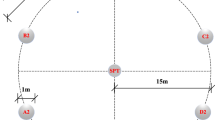Abstract
The current design practice of the bored piles socketed in rock often ignores the end-bearing resistance and relies only on the side shaft resistance. This is due to the accumulation of soft soils as a result of improper cleaning of the slurry suspension at the bottom of the pile construction. This design practice significantly increases the length and cost of the pile foundation. The current study presents the bidirectional load test results on the large-diameter bored piles socketed in weak rocks at the Cua Dai bridge project, Quang Ngai province, Vietnam. The soil profile consists of medium loose to very dense silty sand underlain by the weathered granite rock. The test results and analyses showed that the ultimate shaft resistance and the maximum end-bearing resistance of the granite rock layer are much smaller than those estimated from the unconfined compressive strength of intact rock. The low shaft resistances are attributed to the presence of the slurry filter cake at the interface between the pile shaft and surrounding rock, while the low toe resistances are due to the presence of the soft soils below the pile toe. The importance of the allowable pile toe settlement and the presence of soft soils below pile toe have been addressed to consider the inclusion of end-bearing resistances in design.













Similar content being viewed by others
References
Akgüner C, Kirkit M (2012) Axial bearing capacity of socketed single cast-in-place piles. Soils Found 52:59–68. https://doi.org/10.1016/j.sandf.2012.01.012
Li H, Liu S, Tong L, Xu X (2018) Investigating the resonance compaction effect on laterally loaded piles in layered soil. Eng Geol 246:1–11. https://doi.org/10.1016/j.enggeo.2018.09.019
Li L, Li J, Huang J et al (2017) The bearing capacity of spudcan foundations under combined loading in spatially variable soils. Eng Geol 227:139–148. https://doi.org/10.1016/j.enggeo.2017.03.022
Marino G, Osouli A, Zamiran S, Shafii I (2017) Performance of a pier group foundation in swelling rock. Geotech Geol Eng 35:91–109. https://doi.org/10.1007/s10706-016-0087-6
Rathod D, Krishnanunni KT, Nigitha D (2020) A review on conventional and innovative pile system for offshore wind turbines. Geotech Geol Eng. https://doi.org/10.1007/s10706-020-01254-0
Do H-D, Tran Q-T, Nguyen V-H et al (2021) Performance of foundation on bamboo: geotextile composite improved soft soil in mekong delta through both plate load test and numerical analyses. In: Huang Y-P, Wang W-J, Quoc HA et al (eds) Computational intelligence methods for green technology and sustainable development. Springer, Cham, pp 613–625
Dao DH, Hai NM (2018) Lateral loading test results on single and groups of soil-cement columns. 385–393. doi:https://doi.org/10.1061/9780784481592.038
Do DHA, Pham T (2018) Investigation of performance of soil-cement pile in support of foundation systems for high-rise buildings. Civ Eng J 4:266. https://doi.org/10.28991/cej-030990
Do HD, Pham VN, Nguyen HH et al (2021) Prediction of unconfined compressive strength and flexural strength of cement-stabilized sandy soils: a case study in Vietnam. Geotech Geol Eng 39:4947–4962. https://doi.org/10.1007/s10706-021-01805-z
Do HD, Pham VN, Phan CT et al (2020) Full-scale experimental study on the single and group of soil-cement columns under vertical load applying for buildings. Geotech Test J. https://doi.org/10.1520/GTJ20190210
Bouafia A (2003) Load-settlement behaviour of socketed piles in sandstone. Geotech Geol Eng 21:389–398. https://doi.org/10.1023/B:GEGE.0000006054.41844.53
Omer JR, Delpak R, Robinson RB (2006) A new computer program for pile capacity prediction using CPT data. Geotech Geol Eng 24:399–426. https://doi.org/10.1007/s10706-005-2010-4
Yamin M, Khan Z, El Naggar H, Al Hai N (2018) Nonlinear regression analysis for side resistance of socketed piles in rock formations of Dubai area. Geotech Geol Eng 36:3857–3869. https://doi.org/10.1007/s10706-018-0577-9
Charles W (2001) Side resistance of large diameter bored piles socketed into decomposed rocks. J Geotech Geoenviron Eng 127:642–657
Crapps DK, Schmertmann J (2002) Compression top load reaching shaft bottom: theory versus tests. In: Proceedings of the International Deep Foundations Congress. pp 14–16
Zhang L, Einstein HH (1998) Methods of improving the performance of drilled piers in weak rock. J Geotech Geoenviron Eng ASCE 124:574–584
Zhang L (2010) Prediction of end-bearing capacity of rocksocketed shafts considering rock quality designation (RQD). Can Geotech J 47:1071–1084. https://doi.org/10.1139/T10-016
Doan NP, Park SS, Lee DE (2020) Assessment of Pohang earthquake-induced liquefaction at Youngil-man port using the UBCSAND2 model. Appl Sci. https://doi.org/10.3390/APP10165424
Nguyen BP, Ngo CP, Tran TD et al (2022) Finite element analysis of deformation behavior of deep excavation retained by Diagram Wall in Ho Chi Minh City. Indian Geotech J. https://doi.org/10.1007/s40098-022-00611-5
Kim YS, Tran TQ, Do TM et al (2018) Preliminary evaluation of the earthquake hazard for underground electric facility lines in Pohang City based on ArcGIS. MATEC Web Conf. https://doi.org/10.1051/matecconf/201820601018
Tran TQ, Kim Y, Do TM, et al (2017) Evaluation of the earthquake hazard for underground electric facility lines in Busan area by using Arcgis. pp 57–58
ASTM-D2487-06 (2017) Standard Practice for Classification of Soils for Engineering Purposes (Unified Soil Classification System)
Osterberg J. (1989) Osterberg method. In: Deep Foundations Institute, Int. Conf. on Piling and Deep Foundations. London, pp 421–427
Acknowledgements
This work was supported by The University of Science and Technology, Da Nang University, Vietnam.
Author information
Authors and Affiliations
Corresponding authors
Ethics declarations
Conflict of interest
The authors confirm that this article's content has no conflicts of interest.
Additional information
Publisher's Note
Springer Nature remains neutral with regard to jurisdictional claims in published maps and institutional affiliations.
Rights and permissions
About this article
Cite this article
Dao, D.H., Tran, T.Q., Congress, S.S.C. et al. Evaluating the Performance of Large-Diameter Bored Piles Socketed in Weathered Rock. Indian Geotech J 52, 753–764 (2022). https://doi.org/10.1007/s40098-022-00623-1
Received:
Accepted:
Published:
Issue Date:
DOI: https://doi.org/10.1007/s40098-022-00623-1




